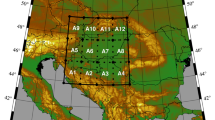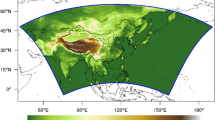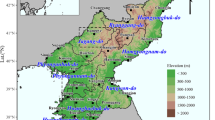Abstract
The sensitivity of surface air temperature response to different grassland types and vegetation cover changes in the regions of temperate grassland of China was analyzed by observation minus reanalysis (OMR) method. The basis of the OMR approach is that reanalysis data are insensitive to local surface properties, so the temperature differences between surface observations and reanalysis can be attributed to land effects. Results showed that growing-season air temperature increased by 0.592 °C/decade in the regions of temperate grassland of China, with about 31 % of observed warming associated with the effects of grassland types and vegetation cover changes. For different grassland types, the growing-season OMR trend was the strongest for temperate desert steppe (0.259 °C/decade) and the weakest for temperate meadow (0.114 °C/decade). Our results suggest that the stronger intraseasonal changes of grassland vegetation are present, the more sensitive the OMR trend responds to the intraseasonal vegetation cover changes. In August and September, the OMR of temperate meadow showed a weak cooling trend. For temperate meadow, about 72.2 and 72.6 % of surface cooling were explained by both grassland type and increase of vegetation cover for August and September, respectively. For temperate steppe and temperate desert steppe, due to the limited soil moisture and little evaporative cooling feedback, the vegetation changes have no significant effect on the surface air temperature. These results indicate that the impact of grassland types and vegetation cover changes should be considered when projecting further climate change in the temperate grassland region of China.





Similar content being viewed by others
References
Bala G, Caldeira K, Wickett M, Phillips TJ, Lobell DB, Delire C, Mirin A (2007) Combined climate and carbon-cycle effects of large-scale deforestation. Proc Natl Acad Sci 104(16):6550–6555
Bonan GB (2008) Forests and climate change: forcings, feedbacks, and the climate benefits of forests. Science 320:1444–1449
Chinese Academy of Sciences (2001) Vegetation atlas of China. Science Press, Beijing
Chuai XW, Huang XJ, Wang WJ, Bao G (2013) NDVI, temperature and precipitation changes and their relationships with different vegetation types during 1998–2007 in Inner Mongolia, China. Int J Climatol 33(7):1696–1706
Dai A, Trenberth KE, Qian T (2004) A global dataset of Palmer drought severity index for 1870–2002: relationship with soil moisture and effects of surface warming. J Hydrometeor 5(6):1117–1130
Dirmeyer PA, Niyogi D, Noblet-Ducoudré ND, Dickinson RE, Snyder PK (2010) Impacts of land use change on climate. Int J Climatol 30(13):1905–1907
Fall S, Niyogi D, Gluhovsky A, Pielke R, Kalnaye E, Rochonf G (2010) Impacts of land use land cover on temperature trends over the continental United States: assessment using the North American Regional Reanalysis. Int J Climatol 30(13):1980–1993
Fang J, Piao S, He J, Ma W (2004) Increasing terrestrial vegetation activity in China, 1982–1999. Sci China Ser C 47:229–240
Frauenfeld OW, Zhang T, Serreze MC (2005) Climate change and variability using European Centre for Medium-Range Weather Forecasts reanalysis (ERA-40) temperatures on the Tibetan Plateau. J Geophys Res 110, D02101
Fu C (2003) Potential impacts of human-induced land cover change on East Asia monsoon. Global Planet Change 37:219–229
Hales K, Neelin JD, Zeng N (2004) Sensitivity of tropical land climate to leaf area index: role of surface conductance versus albedo*. J Clim 17(7):1459–1473
Henderson-Sellers A, Dickinson RE, Durbidge TB, Kennedy PJ, McGuffie K, Pitman AJ (1993) Tropical deforestation: modeling local- to regional-scale climate change. J Geophys Res 98(D4):7289–7315
Hu Y, Dong W, He Y (2010) Impact of land surface forcings on mean and extreme temperature in eastern China. J Geophys Res 115, D19117
Jackson RB, Randerson JT, Canadell JG, Anderson RG, Avissar R, Baldocchi DD, Bonan GB, Caldeira K, Diffenbaugh NS, Field CB, Hungate BA, Jobbágy EG, Kueppers LM, Nosetto MD, Pataki DE (2008) Protecting climate with forests. Environ Res Lett 3(4):044006
Kabat P (2004) Vegetation, water, humans and the climate: a new perspective on an interactive system. Springer, Berlin, pp 566
Kalnay E, Cai M (2003) Impact of urbanization and land-use change on climate. Nature 423(6939):528–531
Kalnay E, Kanamitsu M, Kistler R, Collin W, Deaven D, Gandin L, Iredell M, Saha S, White G, Woollen J, Zhu Y, Leetmaa A, Reynolds R, Chelliah M, Ebisuzaki W, Higgins W, Janowiak J, Mo KC, Ropelewski C, Wang J, Jenne R, Joseph D (1996) The NCEP/NCAR 40-year reanalysis project. Bull Am Meteorol Soc 77(3):437–471
Kalnay E, Cai M, Li H, Tobin J (2006) Estimation of the impact of land-surface forcings on temperature trends in eastern United States. J Geophys Res 111, D06106
Kendall MG (1975) Rank correlation measures. Charles Griffin, London
Lean J, Warrilow DA (1989) Simulation of the regional climatic impact of Amazon deforestation. Nature 342(6248):411–413
Lee R, Yu FF, Price KP, Ellis J, Shi PJ (2002) Evaluating vegetation phenological patterns in Inner Mongolia using NDVI time-series analysis. Int J Remote Sens 23(12):2505–2512
Lim Y, Cai M, Kalnay E, Zhou L (2005) Observational evidence of sensitivity of surface climate changes to land types and urbanization. Geophys Res Lett 32, L22712
Lim Y, Cai M, Kalnay E, Zhou L (2008) Impact of vegetation types on surface temperature change. J Appl Meteorol Climatol 47(2):411–424
Mann HB (1945) Nonparametric tests against trend. Econometrica 13:245–259
Nuñez MN, Ciapessoni HH, Rolla A, Kalnay E, Cai M (2008) Impact of land use and precipitation changes on surface temperature trends in Argentina. J Geophys Res 113, D06111
Pettorelli N, Vik JO, Mysterud A, Gaillard JM, Tucker CJ, Stenseth NC (2005) Using the satellite-derived NDVI to assess ecological responses to environmental change. Trends Ecol Evol 20(9):503–510
Piao S, Mohammat A, Fang J, Cai Q, Feng J (2006) NDVI-based increase in growth of temperate grasslands and its responses to climate changes in China. Global Environ Chang 16(4):340–348
Roger A, Pielke S (2005) Land use and climate change. Science 310(5754):1625–1626
Shen X, Liu B, Li G, Wu Z, Jin Y, Yu P, Zhou D (2014) Spatiotemporal change of diurnal temperature range and its relationship with sunshine duration and precipitation in China. J Geophys Res 119:13163–13179
Simmons AJ, Jones PD, Bechtold VC, Beljaars ACM, Kållberg PW, Saarinen S, Uppala SM, Viterbo P, Wedi N (2004) Comparison of trends and low-frequency variability in CRU, ERA-40, and NCEP/NCAR analyses of surface air temperature. J Geophys Res 109:D24115
Snyder PK, Delire C, Foley JA (2004) Evaluating the influence of different vegetation biomes on the global climate. Clim Dyn 23:279–302
Tucker CJ, Pinzon JE, Brown ME, Slayback DA, Pak EW, Mahoney R, Vermote EF, El Saleous N (2005) An extended AVHRR 8-km NDVI dataset compatible with MODIS and SPOT vegetation NDVI data. Int J Remote Sens 26(20):4485–4498
Wang JX, Gaffen DJ (2001) Late-twentieth-century climatology and trends of surface humidity and temperature in China. J Clim 14(13):2833–2845
Wang Q, Riemann D, Vogt S, Glaser R (2014) Impacts of land cover changes on climate trends in Jiangxi province China. Int J Biometeorol 58(5):645–660
Xiao X, Ojima DS, Parton WJ, Chen Z, Chen D (1995) Sensitivity of Inner Mongolia grasslands to climate change. J Biogeogr 22:643–648
Xu W, Li Q, Wang XL, Yang S, Cao L, Feng Y (2013) Homogenization of Chinese daily surface air temperatures and analysis of trends in the extreme temperature indices. J Geophys Res 118:9708–9720
Xue Y (1996) The impact of desertification in the Mongolian and the Inner Mongolian grassland on the regional climate. J Clim 9(9):2173–2189
Xue Y, Jagadish S (1993) The influence of land surface properties on Sahel climate. Part I: desertification. J Clim 6(12):2232–2245
Yang X, Zhang Y, Liu L, Zhang W, Ding M, Wang Z (2009) Sensitivity of surface air temperature change to land use/cover types in China. Sci China Ser D 52(8):1207–1215
Yang X, Zhang Y, Ding M, Liu L, Wang Z, Gao D (2010) Observational evidence of the impact of vegetation cover on surface air temperature change in China. Chinese J Geophys 53(2):261–269
Zhang JY, Dong WJ, Wu LY, Wei JF, Chen PY, Lee DK (2005) Impact of land use changes on surface warming in China. Adv Atmos Sci 22(3):343–348
Acknowledgments
We gratefully acknowledge the National Natural Science Foundation of China (grant no. 41330640) for funding this work. We also thank Dr. Baba Diabate for his support in English language revision.
Author information
Authors and Affiliations
Corresponding author
Rights and permissions
About this article
Cite this article
Shen, X., Liu, B., Li, G. et al. Impacts of grassland types and vegetation cover changes on surface air temperature in the regions of temperate grassland of China. Theor Appl Climatol 126, 141–150 (2016). https://doi.org/10.1007/s00704-015-1567-y
Received:
Accepted:
Published:
Issue Date:
DOI: https://doi.org/10.1007/s00704-015-1567-y




